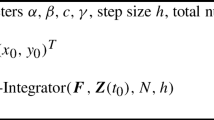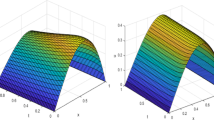Abstract
The study of the paper mainly focuses on recovering the dissipative parameter in a coupled system formed by coupling a bilaplacian operator to a heat equation from final time measured output data via a quasi-solution approach with optimization. The inverse coefficient problem is expressed as a minimization problem. We establish the existence of a minimizer and extract the necessary optimality condition, which is essential in proving the requisite stability result for the inverse coefficient problem. The effectiveness of the proposed approach is demonstrated through an analysis of numerical results using the conjugate gradient approach.









Similar content being viewed by others
Data Availability
Since no data sets were created or examined for this paper, data sharing is not relevant.
References
Abdelhamid, T.: Simultaneous identification of the spatio-temporal dependent heat transfer coefficient and spatially dependent heat flux using an MCGM in a parabolic system. J. Comput. Appl. Math. 328, 164–176 (2018)
Abdelhamid, T., Elsheikh, A.H., Elazab, A., Sharshir, S.W., Selima, E.S., Jiang, D.: Simultaneous reconstruction of the time-dependent Robin coefficient and heat flux in heat conduction problems. Inverse Probl. Sci. Eng. 26, 1231–1248 (2017)
AitBenHassi, E.M., Chorfi, S.E., Maniar, L.: Identification of source terms in heat equation with dynamic boundary conditions. Math. Methods Appl. Sci. 45, 2364–2379 (2022)
Arridge, S.R., Schotland, J.C.: Optical tomography: forward and inverse problems. Inverse Probl. 25, 123010 (2009)
Cao, K., Lesnic, D.: Determination of space-dependent coefficients from temperature measurements using the conjugate gradient method. Numer. Methods Partial Differ. Equ. 34, 1370–1400 (2018)
Cao, K., Lesnic, D.: Reconstruction of the space-dependent perfusion coefficient from final time or time-average temperature measurements. J. Comput. Appl. Math. 337, 150–165 (2018)
Cao, K., Lesnic, D.: Simultaneous reconstruction of the spatially-distributed reaction coefficient, initial temperature and heat source from temperature measurements at different times. Comput. Math. Appl. 78, 3237–3249 (2019)
Carreño, N., Cerpa, E., Mercado, A.: Boundary controllability of a cascade system coupling fourth- and second-order parabolic equations. Syst. Control Lett. 133, 104542 (2019)
Chen, Q., Liu, J.: Solving an inverse parabolic problem by optimization from final measurement data. J. Comput. Appl. Math. 193, 183–203 (2006)
Chorfi, S.E., El Guermai, G., Maniar, L., Zouhair, W.: Numerical identification of initial temperatures in heat equation with dynamic boundary conditions. Mediterr. J. Math. 20, 256 (2023)
Deng, Z.C., Cai, C., Yang, L.: An inverse problem of identifying the diffusion coefficient in a coupled parabolic-elliptic system. Math. Methods Appl. Sci. 41, 3414–3429 (2018)
Deng, Z.C., Yang, L., Yao, B., Wang, L.B.: An inverse problem of determining the shape of rotating body by temperature measurements. Appl. Math. Model. 59, 464–482 (2018)
Deng, Z.C., Yang, L., Yu, J.N., Luo, G.W.: Identifying the diffusion coefficient by optimization from the final observation. Appl. Math. Comput. 219, 4410–4422 (2013)
Erdem, A., Lesnic, D., Hasanov, A.: Identification of a spacewise dependent heat source. Appl. Math. Model. 37, 10231–10244 (2013)
Fletcher, R., Reeves, C.M.: Function minimization by conjugate gradients. Comput. J. 7, 149–154 (1964)
Gnanavel, S., Barani Balan, N., Balachandran, K.: Identification of source terms in the Lotka-Volterra system. J. Inverse Ill-Posed Probl. 20, 287–312 (2012)
Gnanavel, S., Barani Balan, N., Balachandran, K.: Simultaneous identification of parameters and initial datum of reaction diffusion system by optimization method. Appl. Math. Model. 37, 8251–8263 (2013)
Hasanov, A.: Simultaneous determination of source terms in a linear parabolic problem from the final overdetermination: weak solution approach. J. Math. Anal. Appl. 330, 766–779 (2007)
Hasanov, A.: Some new classes of inverse coefficient problems in non-linear mechanics and computational material science. Int. J. Non-Linear Mech. 46, 667–684 (2011)
Hasanov, A., Baysal, O.: Identification of a temporal load in a cantilever beam from measured boundary bending moment. Inverse Probl. 35, 105005 (2019)
Hasanov, A., Baysal, O., Sebu, C.: Identification of an unknown shear force in the Euler-Bernoulli cantilever beam from measured boundary deflection. Inverse Probl. 35, 115008 (2019)
Hasanov, A., Kawano, A.: Identification of unknown spatial load distributions in a vibrating Euler-Bernoulli beam from limited measured data. Inverse Probl. 32, 055004 (2016)
Hasanov, A., Romanov, V.G.: Introduction to Inverse Problems for Differential Equations, 2nd edn. Springer, Cham (2021)
Malomed, B.A., Feng, B.F., Kawahara, T.: Stabilized Kuramoto-Sivashinsky system. Phys. Rev. E 64, 046304 (2001)
Ozisik, M.N., Orlande, H.R.B., Colaco, M.J., Cotta, R.M.: Finite Difference Methods in Heat Transfer, 2nd edn. CRC Press, Boca Raton (2017)
Powell, M.J.D.: Restart procedures for the conjugate gradient method. Math. Program. 12, 241–254 (1977)
Reddy, R.S., Arepally, D., Datta, A.K.: Inverse problems in food engineering: a review. J. Food Eng. 319, 110909 (2022)
Renardy, M., Rogers, B.: An Introduction to Partial Differential Equations. Springer, New York (2004)
Sakthivel, K., Gnanavel, S., Barani Balan, N., Balachandran, K.: Inverse problem for the reaction diffusion system by optimization method. Appl. Math. Model. 35, 571–579 (2011)
Sakthivel, K., Gnanavel, S., Hasanov, A., George, R.K.: Identification of an unknown coefficient in KdV equation from final time measurement. J. Inverse Ill-Posed Probl. 24, 469–487 (2016)
Sakthivel, K., Hasanov, A.: An inverse problem for the KdV equation with Neumann boundary measured data. J. Inverse Ill-Posed Probl. 26, 133–151 (2018)
Salsa, S.: Partial Differential Equations in Action. Springer, Milano (2008)
Samarskii, A.A.: The Theory of Difference Schemes. Marcel Dekker, New York (2001)
Acknowledgements
The authors thank Navaneetha Krishnan Karuppusamy, Central University of Tamil Nadu, India who initiated this work and for the help made in numerical section. The first author thank the University Grants Commission, India for the financial support via CSIR- UGC Junior Research Fellowship (UGC Ref. No.: 1198/(CSIR-UGC NET DEC. 2018)). The National Board for Higher Mathematics has funded the second author’s work with research grant (No.: 02011/13/2022/R &D-II/10206). The last author was supported by SERB through the research grant (No.: SR/FTP/MS-048/2011 dt. 23.06.2014). The authors thank the anonymous referees for their invaluable suggestions which improved the quality of this article.
Funding
The authors have not disclosed any funding.
Author information
Authors and Affiliations
Corresponding author
Ethics declarations
Conflict of interest
The authors have not disclosed any Conflict of interest.
Additional information
Publisher's Note
Springer Nature remains neutral with regard to jurisdictional claims in published maps and institutional affiliations.
Rights and permissions
Springer Nature or its licensor (e.g. a society or other partner) holds exclusive rights to this article under a publishing agreement with the author(s) or other rightsholder(s); author self-archiving of the accepted manuscript version of this article is solely governed by the terms of such publishing agreement and applicable law.
About this article
Cite this article
Murugesan, N.K., Sakthivel, K., Hasanov, A. et al. Inverse Coefficient Problem for the Coupled System of Fourth and Second Order Partial Differential Equations. Appl Math Optim 89, 74 (2024). https://doi.org/10.1007/s00245-024-10142-5
Accepted:
Published:
DOI: https://doi.org/10.1007/s00245-024-10142-5
Keywords
- Inverse problems
- Quasi-solution
- Fr\(\acute{\text {e}}\)chet gradient
- Stability
- Conjugate gradient method




